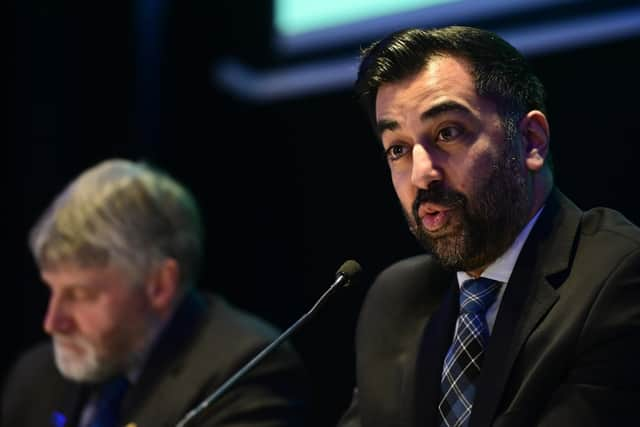Farming Scotland: Humza Yousaf makes direct payment pledge and says Scottish Government will avoid 'cliff edges'
Scottish farmers and crofters have been told they will continue to receive most of their existing subsides as direct payments, as Humza Yousaf pledged to avoid financial “cliff edges”.
The commitment was made by the First Minister in a keynote speech delivered at the National Farmers Union Scotland (NFUS) conference in Glasgow on Friday.
Advertisement
Hide AdAdvertisement
Hide AdGreen campaigners had argued the majority of subsidies, worth about £620 million a year, should be linked to farmers’ efforts to tackle nature loss and climate change.


But Mr Yousaf confirmed 70 per cent of support would continue in the form of direct payments, when a multi-tier system is introduced from 2027 onwards. The remaining 30 per cent of payments will be linked to targeted measures, such as restoring peatlands.
The commitment is close to the existing payment structure, under which farmers and crofters receive 80 per cent of available funding in the form of direct support.
Stakeholders said the pledge would provide a boost to the farming sector’s “confidence”.
Mr Yousaf said in his speech: “This approach is the right one for 2027 – it delivers on our promise not to create cliff edges, but to support you to transition to the new support framework.
“That is what we mean by a just transition … but I also want to be clear about it representing the start of doing things differently.
“You will be expected to deliver far more for nature and climate in return for this funding. You will challenge us, rightly, to ask us to work with you to help ensure our land is more sustainable. I promise you we will do that. And I will also ensure we will admit when we haven't got things right. Sometimes we will create a policy in one department of government and we haven't fully understood the unintended consequences on your way of life - we are going to change that.”
The planned new scheme has four payment tiers – base, enhanced, elective and complementary. The model’s introduction has been linked to Brexit, which means the UK is now in charge of its own subsidies, with some arguing farmers should have to do more to protect the environment in exchange for the money.
Advertisement
Hide AdAdvertisement
Hide AdScottish Liberal Democrat agricultural spokesperson Claire McLaren said the announcement had been “a long time coming”. She said: “Many have been extremely worried about this support dropping off from a cliff edge. The Scottish Government’s slow-footed approach has already caused delays and undermined investment.
“There are still many unknowns here, and that includes what proportion of agriculture funding will be made available to Scotland by Westminster.”
Mr Yousaf said in his speech there was no UK government funding commitment for Scotland’s farmers from 2025. "Right now, we have no idea what Labour or the UK government might do,” he said.
Scottish Environment Link – an organisation representing environmental interests with more than 40 member bodies – said the Scottish Government’s plans largely maintained the status quo.
Eleanor Kay, senior policy adviser for agriculture and climate change at Scottish Land & Estates, said: “The First Minister has set out the allocation of future funding and this will increase the sector’s confidence to some degree.
"However, we have repeatedly made the case for impact assessments and modelling data to be produced by government to explain the rationale for such changes and examine how changes to funding will have an effect. We still need to see this produced.””
Comments
Want to join the conversation? Please or to comment on this article.